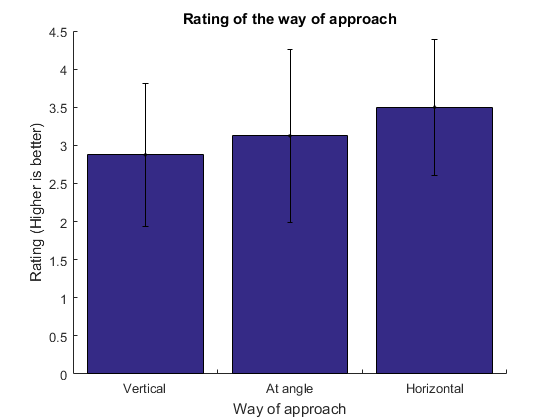PRE2015 3 Groep2 week6
Further testing
NOTE: Experiments in random order.
Due to limited battery time, a small adjustment has been made to the experiment to increase productivity. Instead of testing with only one test subject at the time, two people will be standing next to each other as the drone approaches them. Because of the accuracy of the drone, which is about 0.5 meter, both test subjects should feel as they are being approached by the drone. The test subjects have approved it and indicate that because the full focus is on the drone, it does not influence the results. Afterwards both test subjects are questioned separately so their opinions will not influence each other.
Experiment 2
Results A
| Experiment | Very bad | Bad | Neutral | Good | Very good |
|---|---|---|---|---|---|
| 1A | X | ||||
| 2A | X | ||||
| 3A | X | ||||
| 4A | X | ||||
| 5A | X |
Results B
| Experiment | Very bad | Bad | Neutral | Good | Very good |
|---|---|---|---|---|---|
| 1B | X | ||||
| 2B | X | ||||
| 3B | X | ||||
| 4B | X | ||||
| 5B | X |
Results C
| Experiment | Very bad | Bad | Neutral | Good | Very good |
|---|---|---|---|---|---|
| 1C | X | ||||
| 2C | X | ||||
| 3C | X | ||||
| 4C | X | ||||
| 5C | X |
Analyzing results

T-test
A T-test gives the possibility to decide if an hypotheses needs to be rejected or not [1]. The hypothese in this case are the values: 'Very bad' (1), 'Bad' (2), 'Neutral' (3), 'Good' (4) and 'Very Good' (5). A t-test will be conducted of all the hypotheses value of the different approach routes.
To determine how likely a rating will occur during a specific approach, a p-value will also be computed. This value stand for the probability that an user will rate the experience a certain way.
Shown in the table bellow are the p-values of the different ways of approaching. Values which are rejected by the t-test (one-tailed 95% coincidence interval, α = 0.05) are marked with an 'X'.
| Rating | Vertical | At an angle | Horizontal |
|---|---|---|---|
| Very bad | 0,051606 | X | X |
| Bad | 0,47662 | X | X |
| Neutral | 0,30456 | X | 0,30456 |
| Good | X | 0,3739 | 0,47662 |
| Very good | X | X | 0,051606 |
State of the Art
Being at the brink of being introduced, drone delivery still encounters many problems. Most of these problems are not in autonomous flying however, but mainly in the implementation of these technologies. The first companies are already using less urban areas as their test-grounds. The concept is working, but remains unreliable. The drones still have the tendency to crash into objects and the endless list of unexpected events that can possibly happen ask for a high reaction speed. Also the limited battery lifetime appears to pose problems. Below the pioneers and their progress so far is described.
The leader in the current developments is the Amazon Prime Air concept from Amazon.[2] Unfortunately this is still a concept, but successful flights already have been made. The drone they are using is small plane that has the possibility of vertical takeoff. Flying the drone as a plane increases the speed and range of the drone, resulting in a delivery time of 30 minutes or less and a range of 24 kilometers. As the drone approaches its destination, a message is send to notify the customer that the package is arriving. The drone recognizes its destination by a big 'A' that is placed on the ground. Before lowering itself, the landing area first is scanned for obstacles. After the landing, a small valve is opened releasing the package. Hopes are to be able to make us of this technology around 2020.[3][4]
First version report
Media:First_version_report_group_2_quarter_3_2015-2016.pdf
References
- ↑ Diez, D.M. Barr, C.D. Çetinkaya-Rundel, M. (2012) OpenIntro Statistics. Second Edition
- ↑ Amazon (2016). “Amazon Prime air”
- ↑ Amazon, Amazon Prime Air
- ↑ The Daily Conversation Amazon Prime Air